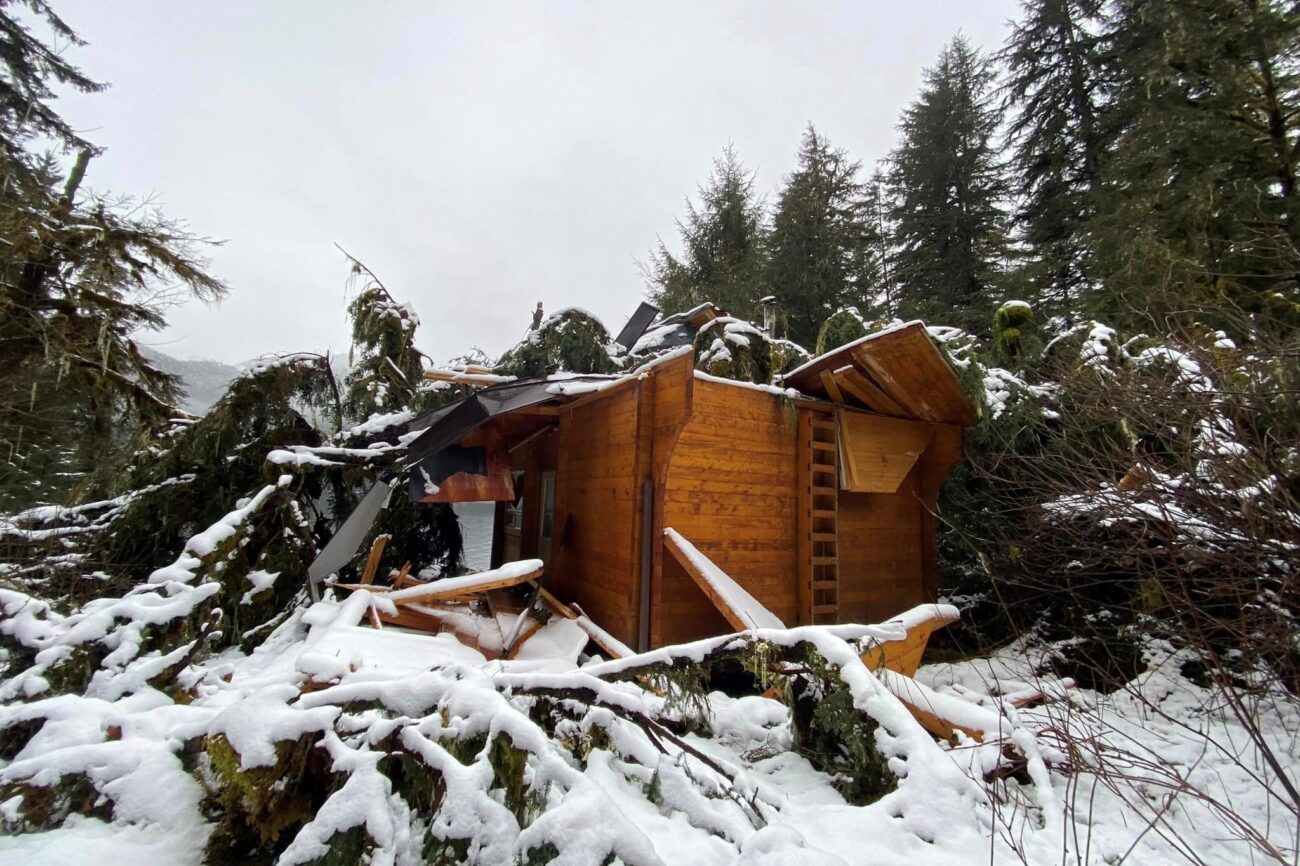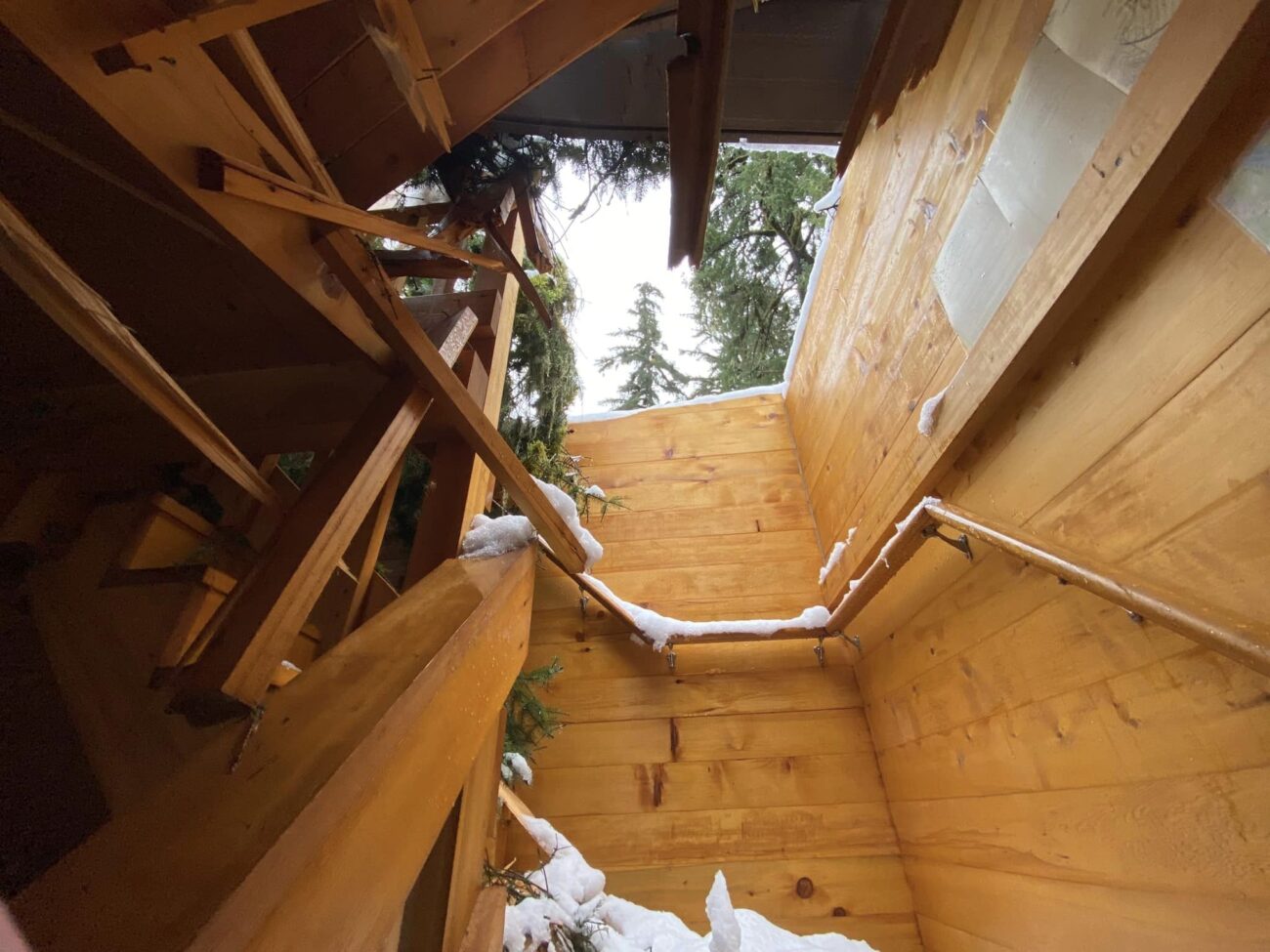
(Courtesy Jeff Owings)
One of the most popular recreation cabins in the Wrangell area fell victim to the forest this winter – it’s been flattened by a spruce tree. And the U.S. Forest Service is uncertain how long a replacement might take.
The turquoise water and rocky beaches of Anan Bay, about 30 miles south of Wrangell on the mainland, are prime Southeast Alaska.
While the site is often associated with bear and other wildlife viewing, the creek and lagoon that feed into Anan Bay have been a central site for fishing, gardening and hunting for Lingít clans for thousands of years.
Jeff Owings spent the better part of three months at Anan last year, working with Ketchikan-based R&M Engineering as an inspector on a large improvement project for the wildlife viewing platform that sits above Anan Creek.
“I was blown away with the beauty of the area,” he says, “And it was about that time that I said to myself: ‘Next early spring, I want to bring my family up for a long weekend.’ So this trip we had, we actually had planned this out for about a year.”

(Courtesy Jeff Owings)
After a 70-mile run from Ketchikan, Owings pulled into Anan Bay in a 46-foot landing craft packed with six adults, four kids, two dogs and their gear.
“I was looking at the face of the cabin and didn’t notice anything right off the bat, so I went up to the top of the roof, which is where we keep the skiff to go back and forth,” Owings relates.
“As I was getting ready to launch the skiff in the water, that’s when I looked over at the cabin and realized I didn’t see a roof,” he continues. “Then I focused in a little more, and that’s when I realized that there was a big tree laying across the cabin.”
He and a friend ran the skiff in, hoping the damage wasn’t as extensive as it looked from the bay, but it was. Much of the back portion of the cabin is smashed, both floors open to the sky.
“It was such a beautiful, beautiful cabin, it was kind of heartbreaking to see that, especially knowing how much love and care went into that entire site,” Owings says.
Acting District Ranger Tory Houser heard from Owings about the damage to the cabin.
“Unfortunately, the cabin is completely unusable,” Houser says. “It’s not safe, the roof is squashed in and the sidewall is completely damaged. And you can see in some of the pictures that the stringers that hold up the roof and the second floor are damaged. [It’s] really bad.”
Houser says that Forest Service staff will head down to do an inspection as soon as possible.
“Our staff are going out as soon as we can get a good weather window to get down there, and we’re gonna check the whole site out and assess the extent of the damage to the cabin on the ground and make a plan for what we can do get trees out of there, that kind of thing, get it cleaned up,” she says.
Checking out the whole site will include the quarter-mile walk up to the Anan Creek Wildlife Observatory deck in case it was a larger blowdown than just one tree.
Owings didn’t go and check on the platform, which he helped oversee construction of, but says he hopes it’s alright.
“I do know that there are some pretty big trees up there by that observatory, all kind of sitting on the rock faces there along the falls, and they might want to get someone to go make sure everything’s okay,” Owings says.
He didn’t notice a ton of blowdowns along the shore – it seemed like the spruce that took out the cabin wasn’t part of a bigger blowdown event.
Houser says it’s likely the Anan Bay Cabin won’t be fixed this summer, and says the Forest Service has been calling folks with reservations to try and shift plans or issue refunds. On the booking site, the cabin is blocked out for the remainder of this year.
For people who had the cabin booked, it’ll be a bit of a blow not only to their camping plans, but potential visits to the wildlife observatory as well. Anan operates on a permit system, and four of the 60 daily permits are set aside for users of the Anan Bay Cabin.
But Houser says she’s hopeful for a relatively quick repair for the cabin.
“The good news is that the Tongass has recently received an influx of funding dedicated to cabins through the bipartisan infrastructure law,” Houser explains, “And we are hoping to pivot and to move funding that Wrangell would receive to the Anan Cabin and get it fixed as quickly as possible. Probably, we’ll have to completely reconstruct.”
Houser says it’s not a totally infrequent occurrence to have a cabin hit by a tree – we are in the largest national forest in the United States, after all. But it seems to be a more catastrophic hit.
But, she says, there is a silver lining: “Thank goodness nobody was in it. Nobody was hurt.”
And even with Owings’ group’s plans foiled by nature – “That was the rough part: all these people were looking forward to this. I’ve been telling my kids about this really for about a year now” – he says the group still had an enjoyable weekend at a nearby cabin they were able to book last-minute.
“We realized that there’s another cabin just right around the corner at Frosty Bay, so we were able to rent that one out and spend our time there, so it wasn’t a total loss,” Owings says. “That’s what we ended up doing for Plan B instead of just heading home.”
Other cabins are often Plan Bs to Anan. Of the 22 other cabins in the Wrangell Ranger District, only two have been used more than Anan Bay over the past three years: Middle Ridge, the only cabin on the Wrangell road system, and Berg Bay, which can be spotted on the boat ride to Anan, down the channel between Wrangell and the mainland.
Despite the upset, Owings adds there isn’t really a great way to avoid trees falling in a forest.
“I think that kind of just comes hand in hand with living in Southeast Alaska – these acts of God that we have to encounter on a daily basis,” Owings says. “I don’t think there’s really much anyone could do about it unless the Forest Service wanted to clear cut everything within a 500-foot diameter of each cabin, and that [would] kind of take away from these cabins and the feeling you get when you’re there.”
Get in touch with KSTK at news@kstk.org or (907) 874-2345.











